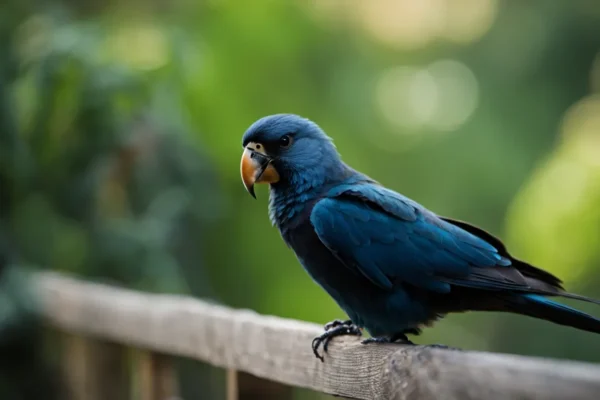Hummingbirds are among the most captivating avian species to see, as they swiftly soar and dive from blossom to blossom. Sometimes it seems almost mystical how they can fly. However, how quickly can these little birds fly?
This is a simple response in case you’re pressed for time: A hummingbird’s normal flying speed is between 25 and 30 mph, but its quickest dives and dashes may reach over 60 mph.
We’ll go over maximum dive speeds, horizontal flight velocities, and other important parameters in this comprehensive tutorial. We’ll also look at the evolutionary modifications that hummingbirds have made to enable such swift flying.
Records for Agility and Speed
Hummingbirds are recognized for their extraordinary swiftness and dexterity while in flight. These little birds are able to do some quite amazing things. Let’s examine some of these amazing species’ speed and agility records in more detail.
Quickest Dives
Hummingbird diving skills are unparalleled. It has been observed that during their swift descents, they may reach velocities of up to 50 mph (80 km/h). They can move quickly and effectively through thick foliage because to their amazing speed, which also helps them escape any predators and find nectar-rich flowers.
Top Speed Horizontal
Hummingbirds can travel at a maximum horizontal speed of quite a bit too. Certain species have been reported to achieve brief bursts of up to 60 miles per hour (97 kilometers per hour) in flight, however, their typical flying speed is between 25 and 30 miles per hour (40 and 48 kilometers per hour).
Because of their extraordinary agility, they can outmaneuver bigger birds and even insects in high-speed chases or while defending their territory.
Reverse Flight
Hummingbirds’ extraordinary ability to fly backward is among their most amazing traits. They are the only species of bird capable of doing this. Hummingbirds can produce enough lift and power to hover in midair or to travel smoothly in any direction, even backwards, by quickly flapping their wings in a figure-eight pattern.
They can reach difficult-to-reach nectar sources and take every last drop of valuable energy because to their amazing talent.
Turns
Hummingbirds can fly backwards in addition to their amazing speed, and they can also do amazing revolutions. Their ability to spin their bodies up to 180 degrees while in midair facilitates quick and seamless direction changes.
This extraordinary dexterity is necessary for dodging predators, seeking possible partners, and negotiating intricate, obstacle-filled habitats.
Observing the speed and dexterity of these small aerial specialists is simply astounding. Their prowess serves as a reminder that even the tiniest animals are capable of amazing achievements, in addition to showcasing nature’s beauties.
See Audubon’s article on how hummingbirds fly backwards and hover to discover more about these amazing birds of flight and hovering.
Average Velocity of Flight
Famous for their amazing speed and agility in flight, hummingbirds are really amazing animals. Let’s examine their typical flying speeds in various situations in more detail.
While Feeding
Hummingbirds exhibit remarkable control and accuracy when it comes to eating. These little birds’ unusual wing shape and quick wing motions allow them to float in midair while they consume nectar from blooms.
Hummingbirds may reach typical flight speeds of 25–30 miles per hour while they are eating. This maximizes their intake of nectar by enabling them to dart from one blossom to another swiftly.
During a regular flight
Hummingbirds fly quickly throughout the day while they are not eating. Depending on the species, they may fly anywhere from 20 to 30 miles per hour on average. Their wings may beat up to 80 times each second, which accounts for their amazing speed.
They are also more agile in the air because to their quick direction changes and hovering abilities.
Migration
Hummingbirds are renowned for their amazing yearly migrations, which take them across great distances. They may fly considerably faster while they are migrating. On long-distance flights, several hummingbird species have been known to reach speeds of up to 50 miles per hour.
These little birds are very resilient; they sometimes travel hundreds of kilometers to get to their breeding or wintering sites.
It’s crucial to remember that the flying speeds shown here are just average estimations that may differ based on a number of variables, such as the specific bird and the surrounding circumstances.
You may get in-depth information and studies on these amazing insects by visiting websites like Audubon or The Hummingbird Society if you’d want to learn more about hummingbirds and their ability to fly.
Specialized Speed Adaptations
Hummingbirds are renowned for their extraordinary quickness and dexterity, which enable them to precisely dart from blossom to bloom and hover in midair. These little birds’ remarkable flying skills are a result of a number of unusual adaptations that they have acquired.
Small Form
A major contributing reason to hummingbirds’ amazing speed is their little stature. They can travel through the air quickly because of their streamlined body structure, which lowers drag. Their usual length is about 3 to 5 inches, and they only weigh a few grams.
They are also more maneuverable and faster because to their lightweight construction, which uses less energy to provide lift. Hummingbirds, despite their small size, can fly at amazing rates of up to 60 miles per hour when they are in level flight.
Wing Structure
Their wings’ distinctive shape is another essential modification for their fast flying. Hummingbirds can hover and change direction swiftly due to their long, thin wings, which allow for fast wingbeats. Up to 80 times per second is an amazing rate of beats for these wings.
In order to improve their agility while in flight, their wings also include a flexible joint-like structure that enables them to spin and alter form. Hummingbirds can do complex aerial feats like flying backwards and even upside down because to their flexibility.
Structure of Feathers
Hummingbirds’ feather structure is also designed to maximize speed. They can fly faster because their feathers are smooth and light, which reduces air resistance. Their feather arrangement gives them control and stability, which allows them to execute precise motions in the air.
Their feathers also have iridescent patterns and vivid colors that are used for communication and courting displays in addition to aesthetic appeal. Because of their quick wingbeats, hummingbirds’ vibrant feathers are sometimes viewed as a blur while they are in flight.
The metabolic process
Another thing that adds to hummingbirds’ speed is their very quick metabolism. They need a steady source of energy to maintain their fast wingbeats and continuous movement. These tiny birds, some of which can beat their wings up to 200 times per second, have the greatest metabolic rates of any known animal.
They often visit hundreds of flowers per day, and in order to power their flight, they must ingest vast quantities of nectar from flowers. In order to save energy while at rest, hummingbirds may also go into a condition of torpor, which involves reducing body temperature and metabolic rate.
Factors Affecting Age, Health, and Speed
A hummingbird’s age and condition may have a big influence on how fast it moves. Birds that are younger and in better health often possess more energy and endurance, which enables them to soar longer and faster. Hummingbirds that are older or less healthy may not be able to fly as fast as they might.
To be in the best possible health for flight, hummingbirds need to have a balanced diet and get the right medical attention.
Weather Situations
A hummingbird’s speed may be greatly affected by the weather. Hummingbirds may find it challenging to maintain their pace and stability when in flight under strong winds. However, suitable weather, including calm breezes and comfortable temperatures, may provide hummingbirds the best flight circumstances possible, enabling them to soar as fast as they can.
It is also known that hummingbirds modify their flight paths in response to meteorological circumstances; for example, they may fly closer to the ground to escape severe winds.
Adaptability vs. Velocity
Hummingbirds are known for their remarkable agility, with the capacity to fly in all directions, even backwards, and to hover in midair. Their short wings and small body size restrict how quickly they can fly, hence their agility is traded off with speed.
Hummingbirds can reverse direction swiftly and hover, which enables them to reach nectar-rich blooms that other birds cannot, even though their peak speed is not the quickest.
It is comparable to owning a sports vehicle that can easily manage tight curves while not having the fastest peak speed.
Were you aware? Depending on the species, hummingbirds may reach different max speeds. One of the most widespread species in North America, the ruby-throated hummingbird, can plunge as fast as 55 miles per hour during courting!
Visit the All About Birds website for further details about hummingbirds and their amazing airborne skills. This website is a reliable resource for both bird lovers and scholars.
In Slow Motion Speed
Hummingbirds are recognized for their extraordinary swiftness and dexterity, which enable them to maneuver through constricted areas and attain remarkable speeds. We can learn more about how quickly these little birds can fly by looking at their wing beats and hovering skills.
Beats of Wings
A hummingbird’s quick wing beats are one of its speed secrets. These birds can flap their wings up to 80 times per second, which is an incredible talent. They can travel quickly between blooms and remain suspended in the air because to their lightning-fast mobility, stopping to feed on nectar as they go.
The hummingbird’s very flexible wings enable them to execute complex aerial acrobatics and rapid direction changes. They can fly forwards, backwards, and even hover in midair because to their ability to twist their wings at the shoulder joint.
It is noteworthy that hummingbirds do not all fly at the same pace. The number of wing beats per second varies across species; some may get up to 200. For instance, the typical wing beat frequency of the Ruby-throated Hummingbird is around 53 beats per second.
lingering
Hummingbirds are renowned for their amazing ability to hover in midair. Hummingbirds can stay still by flapping their wings quickly, in contrast to other birds that must continue moving forward to stay in the air.
They may eat from blossoms that need careful hovering because to their special adaption.
By producing lift on both their up and downstrokes, hummingbirds create a figure-eight motion that allows them to hover. They can stay still and remain stable for long periods of time because of this constant flapping cycle.
Hummingbirds may hover for up to 30 seconds at a time, and some species have even been seen to hover upside down. With their long, specialized beaks, they are able to gather nectar from flowers thanks to their remarkable hovering abilities.
Knowing how fast and agile hummingbirds are helps us appreciate the wonders of nature and serves as an inspiration for future technology developments. In order to create drones and other flying devices that can navigate with a comparable level of efficiency and accuracy, scientists and engineers study these birds.
Visit All About Birds, a thorough website with a wealth of information and beautiful images of these amazing birds, to discover more about hummingbirds and their amazing flight skills.
Final Thoughts
The remarkable evolutionary fine-tuning of a hummingbird’s flight speed is astounding. They can dive as quickly as 60 mph because to their small size and powerful wing strokes.
Hummingbirds amaze onlookers with their quick acceleration and dexterity even at their slower cruising speed. Views in slow motion highlight the complex mechanisms that enable their flying.
No other bird packs such speed and agility into such a compact size. It makes sense that both scientists and lovers of the outdoors are fascinated by hummingbird flying.




![What Birds Lay Blue Eggs? [Complete guide of egg colors]](https://birdsology.com/wp-content/uploads/2022/08/Six-blue-eggs-in-the-nest-600x400.jpg)
![23 Fascinating Birds with Black Mohawks [Images + IDs]](https://birdsology.com/wp-content/uploads/2023/09/14641854748_44dd15150e_b-600x400.jpg)